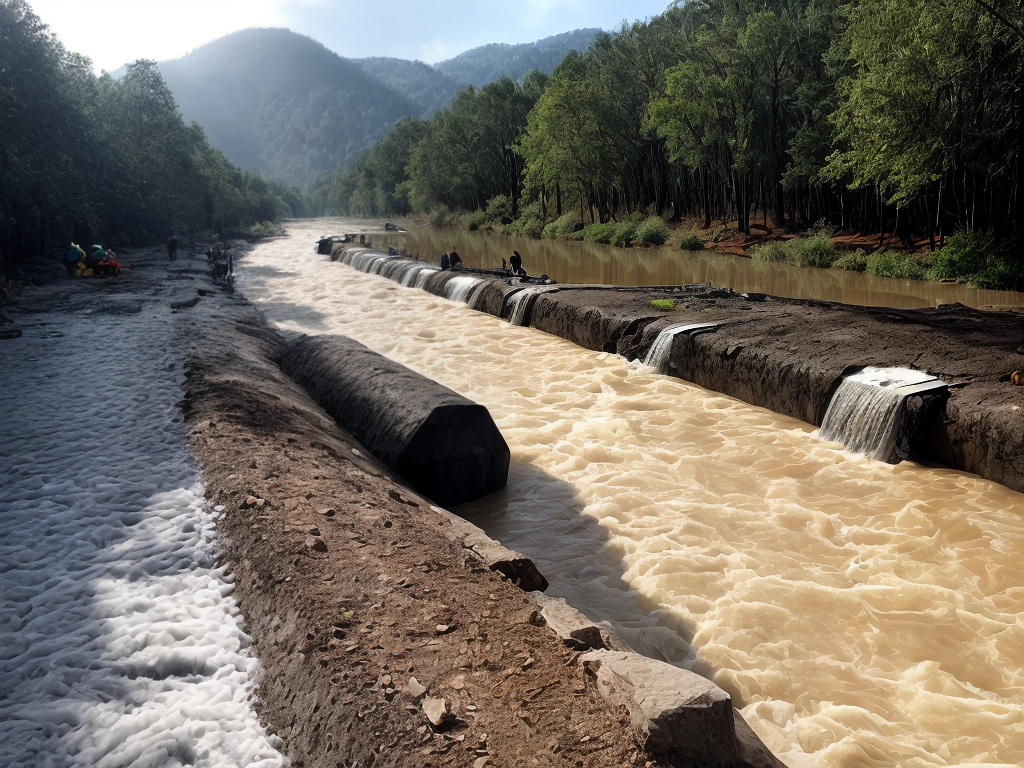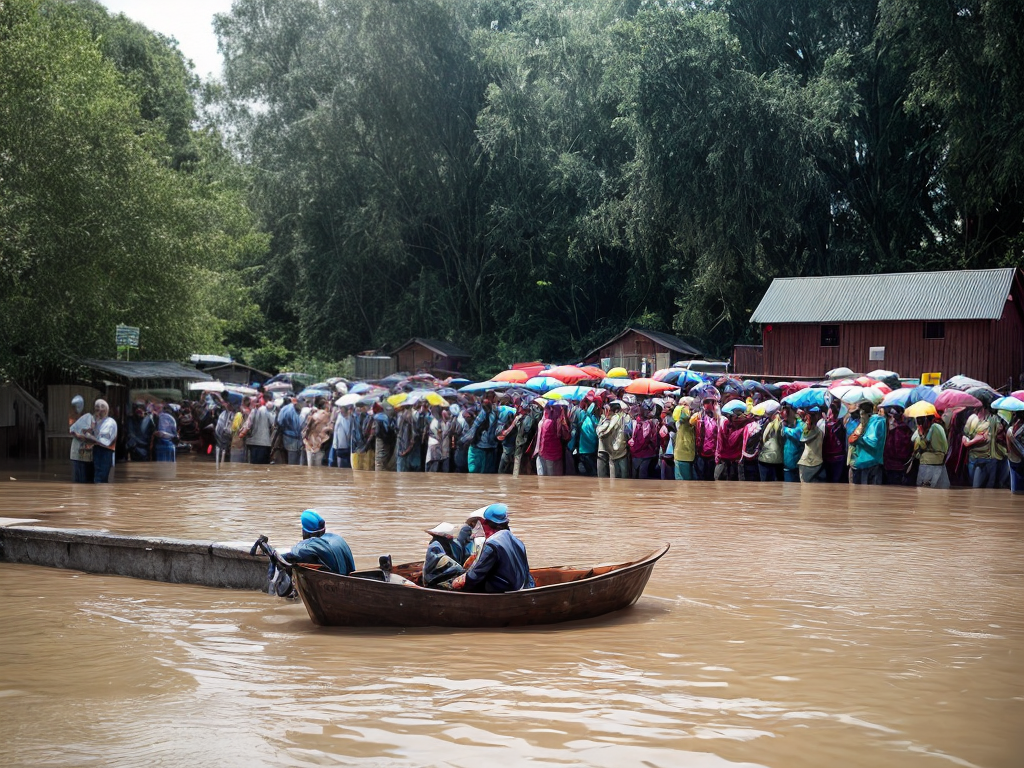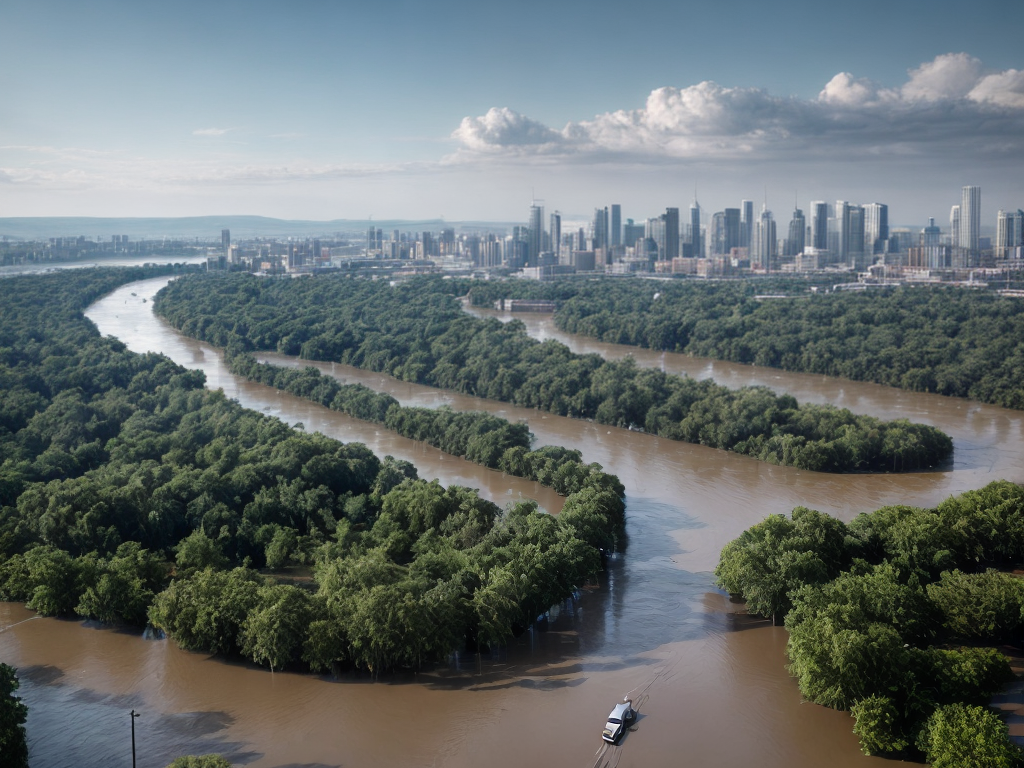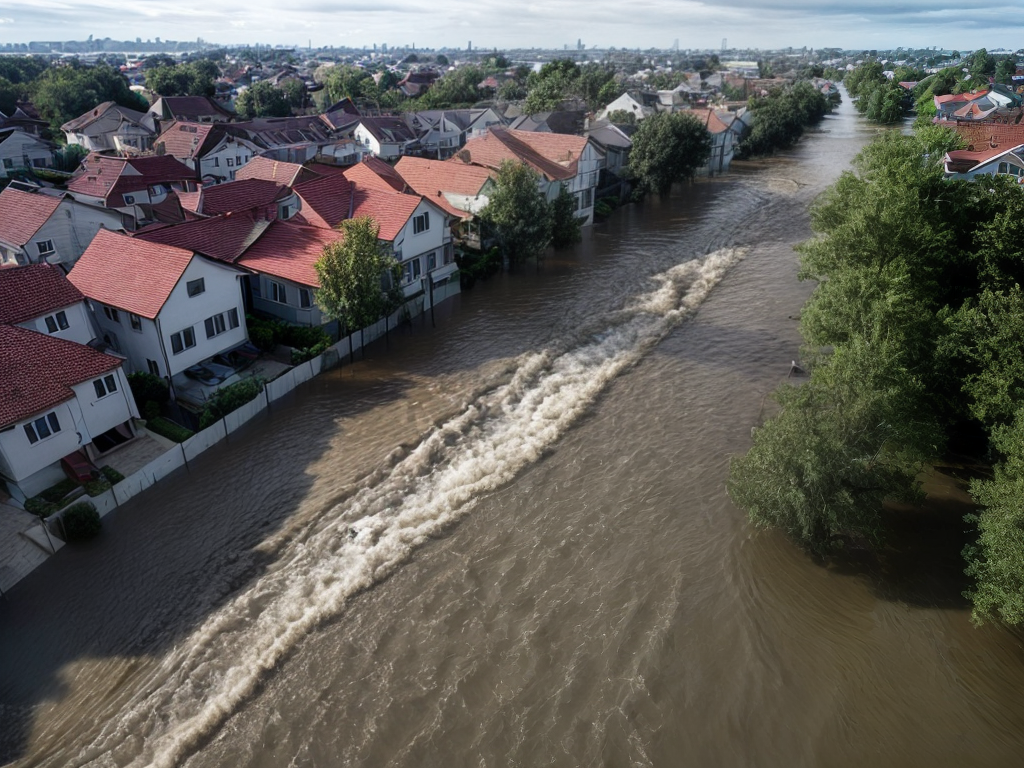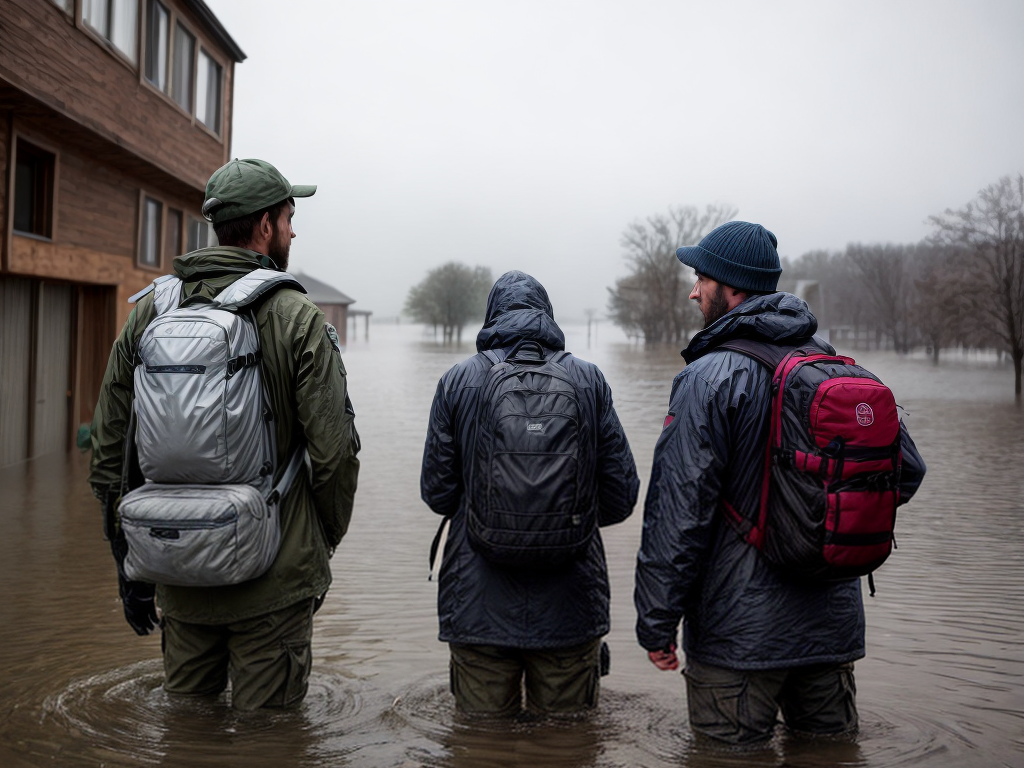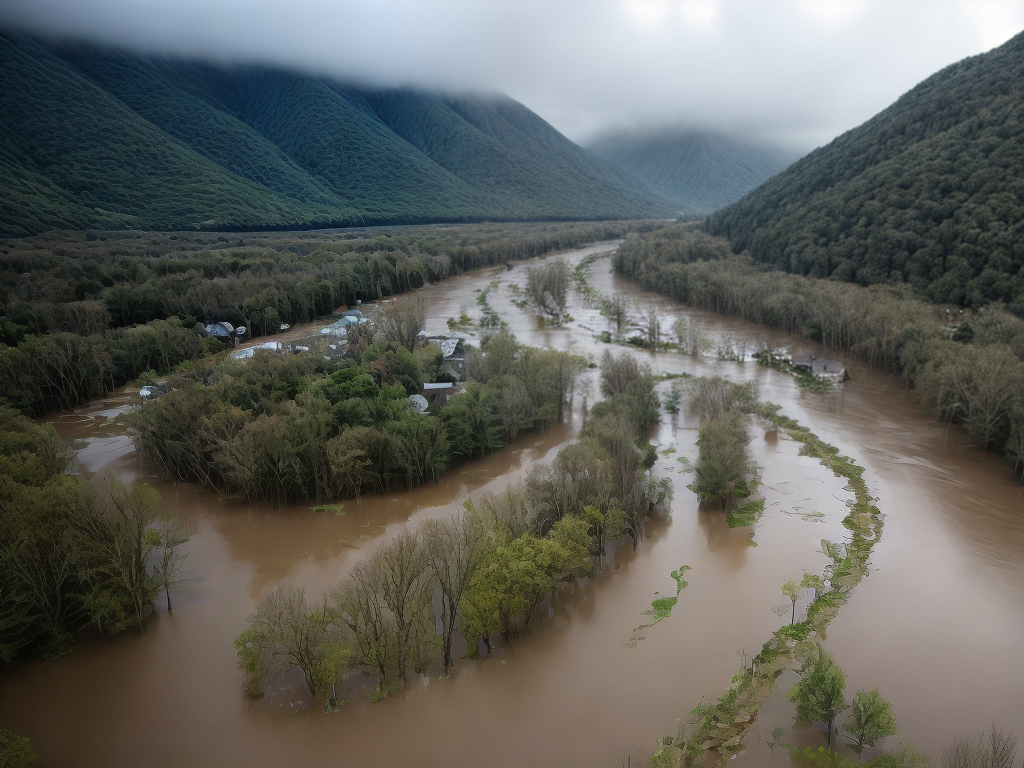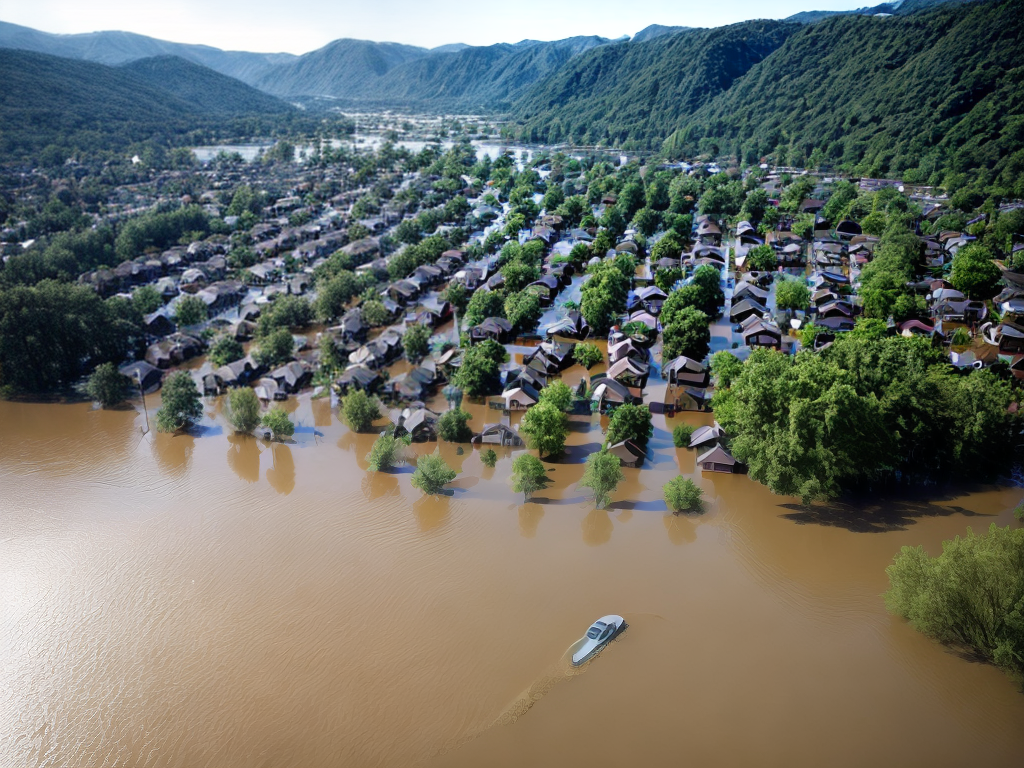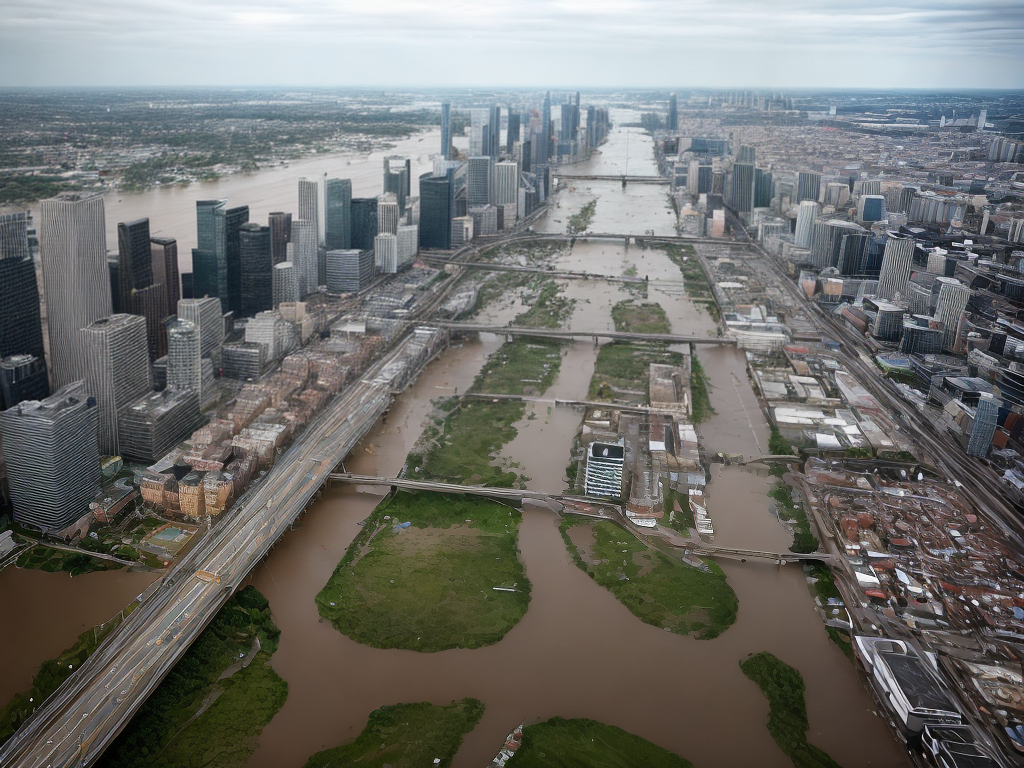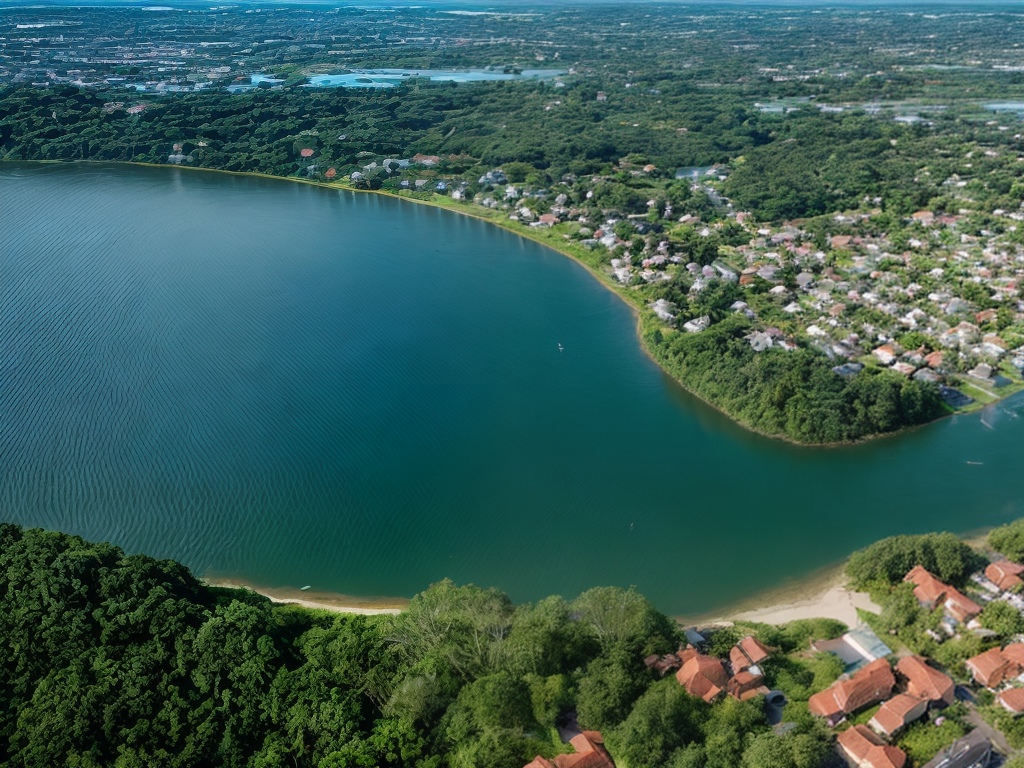
Have you ever wondered how climate change is impacting flooding patterns worldwide? It is an issue that has been gaining significant attention in recent years, and new insights into this complex relationship are shedding light on the future of flood management. In this discussion, we will explore the link between climate change and flooding, the changing frequency and intensity of flood events, global trends in flooding patterns, innovative strategies for flood prevention, and long-term solutions for mitigating flood impacts. Join us as we navigate through the latest research and developments in this critical field, and discover what the future holds for managing floods in a changing climate.
Key Takeaways
- Climate change directly influences the frequency and severity of flooding events worldwide.
- Rising sea levels contribute to more frequent and severe coastal flooding.
- Extreme precipitation events lead to flash floods and overwhelmed drainage systems.
- Changing river patterns, such as altered flow rates and increased sedimentation, increase the risk of riverine flooding.
The Link Between Climate Change and Flooding
Climate change is directly influencing the frequency and severity of flooding events worldwide. This link between climate change and flooding has profound impacts on ecosystems and economic consequences. As the global climate continues to warm, the increased temperatures lead to more intense rainfall events. This excessive rainfall overwhelms existing drainage systems, causing rivers to overflow and flood surrounding areas. The impacts on ecosystems are devastating, as flooding disrupts the delicate balance of biodiversity. Habitats are destroyed, and many plant and animal species face the risk of extinction. Moreover, the economic consequences of flooding cannot be overlooked. The destruction of infrastructure, homes, and businesses results in significant financial losses. Rebuilding and recovery efforts require substantial investments, diverting funds that could have been used for other innovative projects. Additionally, the disruption of supply chains and the loss of agricultural land can lead to food shortages and price increases. These economic consequences not only affect local communities but also have global implications. It is crucial that we address the link between climate change and flooding to develop innovative solutions. This includes implementing more resilient infrastructure, designing flood-resistant buildings, and enhancing early warning systems. Furthermore, we must focus on reducing greenhouse gas emissions to mitigate the impacts of climate change and prevent further exacerbation of flooding events. By taking decisive action, we can protect ecosystems, minimize economic losses, and create a more sustainable future for all.
Impact of Climate Change on Flooding Events
Let’s talk about how climate change is impacting flooding events. Rising sea levels are causing more frequent and severe coastal flooding, putting coastal communities at risk. Extreme precipitation events are becoming more common, leading to flash floods and overwhelmed drainage systems. Additionally, changing river patterns, such as altered flow rates and increased sedimentation, are exacerbating the risk of riverine flooding.
Rising Sea Levels
As the Earth’s climate continues to change, one of the significant impacts we are witnessing is the rise in sea levels, which is directly contributing to an increase in flooding events. Rising sea levels pose a threat to coastal regions worldwide, leading to coastal erosion and the destruction of valuable ecosystems. The combination of higher sea levels and more frequent extreme weather events puts coastal communities at risk of devastating floods and loss of land. To understand the magnitude of this issue, let’s take a look at the following table:
| Region | Current Sea Level (in meters) | Projected Sea Level Rise by 2100 (in meters) |
|---|---|---|
| North America | 0.2 | 0.5-1.2 |
| Europe | 0.1 | 0.3-0.9 |
| Asia | 0.3 | 0.3-1.1 |
These projections highlight the urgent need for innovative solutions to mitigate the effects of rising sea levels and protect vulnerable coastal areas from flooding and erosion.
Extreme Precipitation Events
Extreme precipitation events, fueled by the changing climate, have a significant impact on the occurrence and severity of flooding events. As our climate continues to evolve, it is crucial that we develop innovative adaptation strategies to mitigate the effects of these extreme events. One area that is particularly vulnerable to the impact of extreme precipitation is agriculture. Heavy rainfall can lead to soil erosion, nutrient loss, and crop damage, all of which can have devastating consequences for farmers and food production. To address this challenge, farmers and researchers are exploring new techniques and technologies to enhance water management and improve resilience in the face of extreme precipitation. These include precision irrigation systems, improved drainage infrastructure, and the use of cover crops to protect against soil erosion. By adopting these innovative approaches, we can minimize the impact of extreme precipitation events on agriculture and ensure a more sustainable and food-secure future.
Changing River Patterns
How does climate change impact river patterns and contribute to increased flooding events? Climate change is causing significant changes in river ecosystems, which in turn, have a direct impact on the occurrence and severity of flooding events. Here are five key ways in which climate change is influencing changing river patterns:
- Altered precipitation patterns: Climate change leads to more intense and frequent rainfall events, resulting in increased river discharge and a higher risk of flooding.
- Changes in river flow: Rising temperatures and melting glaciers affect the volume and timing of water flow in rivers, leading to unpredictable flood patterns.
- Erosion and sedimentation: Increased flooding can cause erosion along riverbanks and increased sedimentation, altering the river’s shape and flow patterns.
- Loss of habitat: Changing river patterns disrupt ecosystems, affecting aquatic species and their habitats, leading to biodiversity loss.
- Impact on agriculture: Flooding events can damage crops, destroy farmland, and contaminate water sources, posing significant challenges to agricultural productivity.
Understanding the changing river patterns caused by climate change is essential for developing innovative strategies to mitigate the impact on both ecosystems and agriculture.
Changing Frequency of Flooding Due to Climate Change
Now let’s talk about the changing frequency of flooding due to climate change. We have observed an increase in the occurrences of floods, with more frequent and intense events happening in many regions. This alteration in flood patterns has significant implications for communities and ecosystems worldwide.
Increased Flood Occurrences
Climate change has caused an increase in the frequency of flooding events. This changing flood dynamics has significant implications for our communities. Here are some key insights into the increased flood occurrences:
- More intense rainfall: Warmer temperatures lead to increased evaporation, resulting in heavier rainfall during storms.
- Rising sea levels: As global temperatures rise, ice caps and glaciers melt, causing sea levels to rise and increasing the risk of coastal flooding.
- Altered precipitation patterns: Climate change disrupts traditional weather patterns, causing shifts in where and when rainfall occurs, leading to unexpected flooding in new areas.
- Urbanization and infrastructure: Rapid urbanization and inadequate infrastructure exacerbate the impact of flooding, as cities struggle to handle increased water flow.
- Ecological changes: Climate change affects ecosystems, altering natural flood mitigation processes, such as wetlands and forests, which can contribute to increased flood frequency.
Understanding these factors is crucial for developing innovative solutions to mitigate the impacts of increased flooding and ensure the resilience of our communities.
Altered Flood Patterns
As we consider the impacts of increased flood occurrences, it is important to delve into the altered flood patterns resulting from climate change. Climate change is not only causing an increase in the frequency of floods, but it is also changing the dynamics of these floods. Altered flood patterns refer to the shifts in the timing, magnitude, and duration of flooding events. These changes are a result of various factors, including rising sea levels, changing precipitation patterns, and melting glaciers. As a result, regions that were once considered safe from floods may now face a higher risk. Understanding these changing flood dynamics is crucial for developing innovative strategies to mitigate the impacts of floods and ensure the resilience of communities in the face of climate change.
Intensification of Flood Events Under Climate Change
Our findings suggest that flood events are becoming increasingly severe and frequent due to the impact of climate change. This intensification of flood events has significant implications for flood response strategies and the economy. Here are some key points to consider:
- Increased vulnerability: As flood events become more intense, existing flood response strategies may be insufficient to handle the growing risks. Innovative approaches are needed to enhance resilience and adaptability in the face of changing flood patterns.
- Costly damages: The economic implications of intensified flood events are staggering. The damages caused by floods, including infrastructure destruction, property damage, and disruptions to businesses, can have long-lasting effects on local and national economies. Finding innovative and cost-effective ways to mitigate these damages is crucial.
- Insurance challenges: The increasing severity and frequency of floods pose challenges for insurance companies. Traditional insurance models may need to be reevaluated to ensure that individuals and businesses are adequately protected against flood-related losses. Innovations in risk assessment and insurance products can provide more comprehensive coverage and better support for those affected.
- Technological advancements: Innovation plays a vital role in improving flood response and mitigation strategies. Advanced forecasting models, real-time monitoring systems, and early warning systems can help communities prepare and respond more effectively to flood events. Embracing technological advancements and integrating them into existing flood management plans is essential.
- Collaborative approaches: Addressing the intensification of flood events requires collaboration among various stakeholders, including government agencies, researchers, engineers, and local communities. Innovative partnerships and knowledge-sharing platforms can facilitate the development and implementation of effective flood response strategies.
Global Trends in Flooding Patterns
Global flooding patterns have undergone significant changes in recent years. As our planet continues to experience the effects of climate change, the risk of flooding has increased on a global scale. Understanding these global flood patterns is crucial for developing innovative strategies to mitigate the impact of climate change and reduce flood risk.
One noticeable trend in global flood patterns is the increase in the frequency and intensity of extreme rainfall events. Warmer temperatures lead to more evaporation, resulting in an atmosphere that can hold more moisture. This excess moisture can then be released as heavy rainfall, causing rivers to overflow and leading to widespread flooding. Furthermore, rising sea levels, another consequence of climate change, exacerbate the risk of coastal flooding.
Another significant global trend is the shifting of flood-prone areas. As weather patterns change, some regions may experience an increase in flooding, while others may see a decrease. This shift can have profound implications for communities and ecosystems, requiring innovative adaptation measures to manage flood risk effectively.
Additionally, the duration and timing of flood events are changing globally. Some areas are experiencing longer flood seasons, while others are seeing an increase in flash floods that occur more frequently. These changes pose challenges for infrastructure planning and emergency response systems, demanding innovative solutions to protect vulnerable populations and minimize damage.
Regional Variations in Flood Occurrence
The changing flood patterns around the world necessitate an examination of regional variations in flood occurrence. Understanding these regional flood patterns is crucial for effective climate change adaptation strategies. Here are some key insights on regional flood occurrence:
- Geographical Factors: Different regions experience varying levels of flood occurrence due to geographical factors such as proximity to rivers, coastlines, or mountainous areas. These factors can amplify or mitigate flood risks in specific regions.
- Weather Patterns: Regional flood occurrence is heavily influenced by local weather patterns. Some regions may experience frequent heavy rainfall events, while others may be prone to hurricanes or monsoons. These weather patterns directly impact the frequency and intensity of floods in different areas.
- Infrastructure Development: The level of infrastructure development in a region can significantly affect flood occurrence. Urban areas with inadequate drainage systems or poor land management practices may experience more severe flooding compared to regions with well-designed infrastructure.
- Land Use Changes: Changes in land use, such as deforestation or urbanization, can alter the natural flow of water and increase flood risks. Understanding the impact of land use changes on regional flood patterns is crucial for effective climate change adaptation planning.
- Community Resilience: The resilience of local communities in the face of floods plays a vital role in mitigating the impacts of flooding. Building community resilience through early warning systems, flood-resistant infrastructure, and effective disaster management strategies is essential for adapting to regional flood patterns.
Climate Change and Urban Flooding
What are the impacts of climate change on urban flooding? As the world continues to grapple with the effects of climate change, urban areas are increasingly vulnerable to flooding. The rise in global temperatures and extreme weather events, such as heavy rainfall, are exacerbating the risk of flooding in cities. This poses significant challenges for urban planning and flood preparedness.
Urban planning plays a crucial role in mitigating the impacts of climate change on urban flooding. Innovative approaches are needed to ensure that cities are designed to withstand and adapt to changing weather patterns. This includes incorporating green infrastructure, such as permeable pavements and green roofs, which can absorb and manage excess rainfall. Additionally, urban planners can implement zoning regulations that restrict construction in flood-prone areas, preventing further development in high-risk zones.
Flood preparedness is another critical aspect in addressing urban flooding in the face of climate change. Innovative technologies and early warning systems can provide timely information about potential flooding events, allowing authorities to take preventive measures and evacuate residents if necessary. Improved drainage systems and flood barriers can also help to mitigate the impact of flooding in urban areas.
Furthermore, community engagement and education are essential for enhancing flood preparedness. By raising awareness about the risks of urban flooding and providing information on preventive measures, residents can be better equipped to respond to flooding events and minimize damage.
Implications for Infrastructure and Development
As we consider the impacts of climate change on urban flooding, it is crucial to recognize the significant implications it has for infrastructure and development. The effects of climate change are not limited to rising sea levels and extreme weather events; they also have profound consequences for our cities and their ability to adapt and thrive. Here are some key implications for infrastructure and development:
- Increased vulnerability: Climate change brings more frequent and intense flooding, putting our infrastructure at greater risk. Roads, bridges, and buildings may be damaged or rendered unusable, disrupting transportation networks and hindering economic development.
- Higher costs: Rebuilding and repairing damaged infrastructure is expensive. As flooding becomes more frequent and severe, the financial burden on governments and communities will increase, diverting resources from other important initiatives.
- Need for climate-resilient infrastructure: To withstand the impacts of climate change, our infrastructure must be designed and built with resilience in mind. This includes incorporating features such as flood-resistant materials, improved drainage systems, and elevated structures.
- Opportunities for innovation: Climate change adaptation presents an opportunity for innovation and technological advancements. Developing new materials, construction techniques, and infrastructure designs can help us create more resilient and sustainable cities.
- Collaboration and planning: Addressing the implications of climate change on infrastructure requires collaboration between various stakeholders, including governments, businesses, and communities. Effective planning and coordination are essential to ensure that our cities are prepared for the challenges ahead.
Adapting to Changing Flood Risks
Now let’s talk about how we can adapt to the changing flood risks caused by climate change. The first point to consider is risk assessment and planning, where we need to identify vulnerable areas and develop strategies to mitigate the impact of floods. Infrastructure and flood management is another crucial aspect, as we must ensure that our infrastructure is resilient and capable of handling increased flood events. Lastly, community engagement and education play a vital role in raising awareness and promoting preparedness among the population.
Risk Assessment and Planning
Our approach to managing changing flood risks involves conducting thorough risk assessments and developing comprehensive adaptation plans. By combining innovative strategies and advanced technologies, we can effectively mitigate the impacts of flooding on urban areas. Here are some key elements of our risk assessment and planning process:
- Utilizing cutting-edge data analysis tools to identify vulnerable areas and prioritize intervention.
- Collaborating with urban planners and architects to integrate flood resilience into city designs.
- Implementing nature-based solutions such as green infrastructure and floodplain restoration to enhance resilience.
- Employing real-time monitoring systems to provide early warning and enable rapid response.
- Engaging with local communities to raise awareness, encourage participation, and foster a culture of resilience.
Through these proactive measures, we aim to build cities that not only withstand flooding but thrive in the face of climate change.
Infrastructure and Flood Management
To effectively adapt to changing flood risks, we must now focus on the crucial aspect of infrastructure and flood management. As climate change continues to impact our environment, it is imperative that we invest in resilient flood infrastructure and enhance our flood risk assessment capabilities. By integrating innovative technologies and data-driven approaches, we can create a more adaptive and responsive flood management system.
One key element in infrastructure development is the construction of flood-resistant buildings and transportation systems. These structures should be designed to withstand extreme weather events and ensure the safety of residents and commuters. Additionally, implementing effective flood risk assessment methods is vital in identifying vulnerable areas and developing appropriate mitigation strategies. This involves utilizing advanced modeling techniques and real-time monitoring systems to accurately predict and respond to flood events.
By integrating these measures into our infrastructure and flood management practices, we can proactively adapt to changing flood risks and build a more resilient future.
| Flood Infrastructure | Flood Risk Assessment |
|---|---|
| Resilient buildings and transportation systems | Advanced modeling techniques |
| Flood-resistant construction materials | Real-time monitoring systems |
| Green infrastructure solutions | Vulnerability mapping |
Community Engagement and Education
Engaging and educating communities is essential for effectively adapting to the changing flood risks we face. In order to foster innovation and create resilient communities, we must prioritize community engagement and implement educational initiatives. Here are five key strategies to promote community engagement and education:
- Establish community-led flood risk assessment programs to empower individuals and encourage active participation in flood management decisions.
- Develop interactive workshops and training sessions to educate community members about flood risks, mitigation strategies, and the importance of early warning systems.
- Foster partnerships between local governments, educational institutions, and community organizations to enhance flood education programs and reach a wider audience.
- Utilize innovative technologies, such as virtual reality and interactive simulations, to create immersive learning experiences that effectively convey the impacts of flooding.
- Encourage peer-to-peer knowledge sharing and community-led initiatives, empowering individuals to take ownership of their flood resilience and promote sustainable practices.
Role of Policymakers in Flood Management
Policymakers play a crucial role in managing floods and mitigating their impact on communities and the environment. Effective policy implementation is essential for addressing the challenges posed by climate change and flooding patterns. By developing and implementing proactive policies, policymakers can ensure that communities are well-prepared to handle flood events and minimize their negative consequences.
One key aspect of flood management that policymakers must prioritize is stakeholder involvement. Engaging with various stakeholders, such as local communities, businesses, and environmental organizations, is vital for creating comprehensive and effective flood management strategies. By involving all relevant parties in the decision-making process, policymakers can gain valuable insights, foster collaboration, and ensure that the needs and concerns of all stakeholders are addressed.
Furthermore, policymakers must focus on innovation when developing flood management policies. The ever-changing nature of climate change and flooding patterns requires adaptive and forward-thinking approaches. By embracing new technologies, data-driven solutions, and innovative strategies, policymakers can enhance the effectiveness of flood management efforts. This can include utilizing advanced modeling techniques to predict flood risks, implementing sustainable infrastructure projects, and exploring nature-based solutions that can help absorb and manage excess water.
In addition to these measures, policymakers should prioritize the integration of climate change adaptation and mitigation strategies into flood management policies. By recognizing the interconnectedness between climate change and flooding, policymakers can develop comprehensive strategies that address both the immediate and long-term impacts of floods. This can involve promoting green infrastructure, supporting renewable energy initiatives, and implementing measures to reduce greenhouse gas emissions.
Community Resilience in the Face of Flooding
Given the importance of stakeholder involvement and innovative strategies in flood management, it is crucial to examine the concept of community resilience in the face of flooding. Community resilience refers to the ability of a community to withstand and recover from the impacts of flooding, while also adapting and learning from the experience. In order to foster community resilience, there are several key factors that need to be considered:
- Community engagement: Engaging the community in flood preparedness efforts is essential for building resilience. This can involve education and awareness campaigns, community meetings, and involving community members in decision-making processes. By involving the community, we can tap into their local knowledge and resources, creating a sense of ownership and empowerment.
- Flood preparedness: Developing and implementing flood preparedness plans is crucial for community resilience. This includes early warning systems, evacuation plans, and infrastructure improvements. By being prepared, communities can effectively respond to flooding events and minimize the impact on their lives and livelihoods.
- Collaboration and partnerships: Building partnerships with various stakeholders, such as government agencies, non-profit organizations, and the private sector, is essential for community resilience. By working together, we can leverage resources, expertise, and innovative solutions to address the challenges posed by flooding.
- Innovative technologies: Embracing innovative technologies can greatly enhance community resilience. This can include the use of remote sensing and data analytics to predict and monitor flood events, as well as the development of resilient infrastructure and green infrastructure solutions.
- Capacity building: Building the capacity of community members, local authorities, and organizations is crucial for long-term resilience. This can involve training programs, workshops, and knowledge sharing platforms to equip individuals and communities with the necessary skills and knowledge to effectively respond to and recover from flooding events.
Innovative Strategies for Flood Prevention
Let’s talk about some innovative strategies for flood prevention. One important aspect is conducting a thorough risk assessment for floods to determine the areas most susceptible to flooding. Additionally, implementing sustainable flood management practices can help mitigate the impact of floods and protect communities in the long run.
Risk Assessment for Floods
Innovative strategies for flood prevention require a thorough risk assessment to effectively mitigate the impacts of climate change. To achieve this, we employ advanced flood risk modeling techniques that analyze various factors such as topography, hydrology, and historical flood data. This allows us to identify areas that are most vulnerable to flooding and prioritize our flood preparedness measures accordingly. Our risk assessment process includes the following key steps:
- Collecting and analyzing data on rainfall patterns, water levels, and river flow rates.
- Incorporating climate change projections to anticipate future flood scenarios.
- Assessing the vulnerability of infrastructure and communities to flooding.
- Engaging with local stakeholders to gather valuable insights and enhance community resilience.
- Continuously monitoring and updating our risk assessment models to adapt to changing conditions.
Sustainable Flood Management
To effectively prevent floods and manage their impacts, we employ sustainable flood management strategies that prioritize long-term resilience and environmental conservation. In order to achieve this, we focus on the development of sustainable flood infrastructure and eco-friendly flood prevention methods. Our innovative approach combines engineering solutions with nature-based approaches to create a comprehensive and effective flood management system.
One key aspect of our sustainable flood management strategy is the implementation of green infrastructure. By utilizing natural features such as wetlands, floodplains, and green spaces, we can absorb and store excess water, reducing the risk of flooding in urban areas. Additionally, we promote the use of permeable pavements and green roofs to enhance water infiltration and reduce runoff.
Furthermore, we prioritize the restoration and preservation of natural ecosystems, which not only contribute to flood prevention but also provide valuable habitats for wildlife and enhance the overall biodiversity of the area. By maintaining a balance between engineering solutions and ecological considerations, we can achieve sustainable flood management that benefits both humans and the environment.
Long-Term Solutions for Mitigating Flood Impacts
Implementing effective long-term solutions is crucial for mitigating the impacts of flooding caused by climate change. As we strive to address the increasing challenges posed by floods, it is important to develop innovative strategies that promote long term resilience and reduce flood risk. Here are some key approaches that can help us achieve these goals:
- Natural flood management: Embracing nature-based solutions can enhance our resilience to floods. By restoring wetlands, creating floodplain storage areas, and implementing sustainable drainage systems, we can improve floodwater retention and reduce the risk of downstream flooding.
- Climate-resilient infrastructure: Investing in infrastructure that can withstand the impacts of climate change is essential. By incorporating resilient design principles and considering future climate scenarios, we can reduce the vulnerability of our communities to flooding.
- Integrated water management: Taking a holistic approach to water management can help us manage flood risk more effectively. By coordinating actions across different sectors, such as agriculture, urban planning, and water supply, we can optimize the use of resources and minimize the impacts of floods.
- Community engagement and education: Empowering communities through education and engagement is crucial for building resilience. By raising awareness about flood risks, promoting emergency preparedness, and involving local communities in decision-making processes, we can enhance our collective ability to respond to and recover from floods.
- Data-driven decision making: Utilizing advanced technologies and data analytics can enable us to make informed decisions regarding flood risk reduction. By integrating real-time monitoring systems, predictive modeling, and risk assessment tools, we can enhance our understanding of flood dynamics and improve our ability to plan and respond effectively.
Balancing Climate Change Mitigation and Adaptation
As we continue our exploration of addressing flood impacts, it is important to strike a balance between mitigating climate change and adapting to its effects. Balancing adaptation strategies with climate change mitigation efforts is crucial in our pursuit of innovative solutions to combat the challenges posed by changing flood patterns.
In order to effectively address the impacts of climate change, it is necessary to simultaneously focus on both mitigation and adaptation strategies. Mitigation efforts aim to reduce greenhouse gas emissions and limit further climate change, while adaptation focuses on preparing for and managing the current and future impacts of climate change. Balancing these two approaches is essential for long-term resilience and sustainability.
One way to strike this balance is through the implementation of nature-based solutions. These strategies harness the power of ecosystems to both mitigate climate change and adapt to its effects. For example, the restoration of wetlands can help absorb and store carbon dioxide, reducing the amount of greenhouse gases in the atmosphere. At the same time, wetlands act as natural buffers, absorbing floodwaters and reducing the risk of flooding in surrounding areas.
Another key aspect of balancing adaptation and mitigation is integrating climate considerations into urban planning and infrastructure development. By incorporating climate-resilient design principles into the construction of buildings, roads, and drainage systems, cities can better withstand extreme weather events and minimize the need for costly repairs in the future. Additionally, investing in renewable energy sources can simultaneously reduce greenhouse gas emissions and increase energy resilience, enhancing our ability to adapt to climate change.
The Future of Flood Management in a Changing Climate
In light of the changing climate, the future of flood management necessitates innovative approaches and a proactive mindset. As we face the challenges of increasing flood risks and changing precipitation patterns, it is crucial to explore new strategies to mitigate and adapt to these hazards. Here are some key considerations for the future of flood management:
- Embracing nature-based solutions: Incorporating natural features, such as wetlands and green spaces, can help absorb excess water and reduce the impact of flooding. These nature-based solutions not only provide effective flood control but also offer additional benefits like enhancing biodiversity and improving water quality.
- Investing in advanced technology: Advancements in technology can greatly enhance flood management efforts. From real-time monitoring systems to predictive modeling, innovative technologies can help us better understand flood patterns, provide early warnings, and inform decision-making to minimize damage and protect lives.
- Promoting community engagement: Building resilient communities requires active participation from individuals, businesses, and local authorities. Encouraging community engagement through education, awareness campaigns, and citizen science initiatives can foster a sense of ownership and empower communities to take proactive measures against flooding.
- Rethinking flood insurance: With the increasing frequency and severity of floods, the future of flood insurance needs to be reevaluated. Insurance policies should consider the changing climate risks and incorporate innovative approaches, such as parametric insurance and risk-sharing mechanisms, to ensure affordable and comprehensive coverage for all.
- Practicing integrated flood management: Addressing the multifaceted nature of flood risks requires a holistic approach. Integrated flood management involves coordination between different sectors, such as water resource management, urban planning, and agriculture, to develop comprehensive strategies that minimize flood impacts while considering other societal needs.

